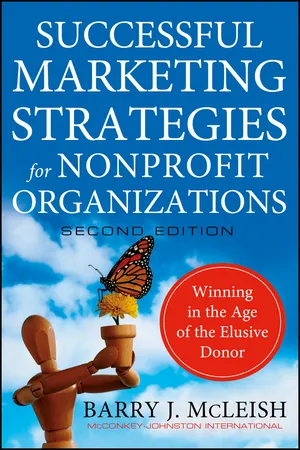
Successful Marketing Strategies for Nonprofit Organizations
Winning in the Age of the Elusive Donor
- English
- ePUB (mobile friendly)
- Available on iOS & Android
Successful Marketing Strategies for Nonprofit Organizations
Winning in the Age of the Elusive Donor
About this book
From a leading expert on nonprofit marketing, the only marketing handbook a nonprofit manager will ever need-now fully revised and updated
In Successful Marketing Strategies for Nonprofit Organizations, Second Edition, nonprofit marketing guru Barry J. McLeish shares everything he's learned during more than two decades managing and consulting nonprofits of every shape and size. Skipping all the arcane theory and the business school jargon, he gives you clear, step-by-step advice and guidance and all the tools you need to develop and implement a sophisticated marketing program tailored to your organization's needs and goals.
- New sections on the new media available to nonprofit marketers
- Techniques for analyzing your market and developing a comprehensive marketing plan
- Marketing strategies that will support fund-raising, promote new services, and enhance your organization's reputation and visibility
- Methods for developing a marketing program that reaches both the consumers of your service and the donors who support your organization
Do you need to breathe new life into your existing marketing department? Successful Marketing Strategies for Nonprofit Organizations, Second Edition gives you the tools, the know-how, and the confidence you need to succeed.
Frequently asked questions
- Essential is ideal for learners and professionals who enjoy exploring a wide range of subjects. Access the Essential Library with 800,000+ trusted titles and best-sellers across business, personal growth, and the humanities. Includes unlimited reading time and Standard Read Aloud voice.
- Complete: Perfect for advanced learners and researchers needing full, unrestricted access. Unlock 1.4M+ books across hundreds of subjects, including academic and specialized titles. The Complete Plan also includes advanced features like Premium Read Aloud and Research Assistant.
Please note we cannot support devices running on iOS 13 and Android 7 or earlier. Learn more about using the app.
Information
PART I
INTRODUCTION
CHAPTER 1
A New Way of Doing Business for the Nonprofit Organization
Whereas the nonprofit sector used to be regarded as a sort of backwater to the business world, as a poor cousin to the formidable public sector, it is now increasingly becoming a destination of first resort. Not only is talent flocking there—giving the other sectors a run for their money in terms of employees—but with its emerging blend of businesslike discipline and government-like compassion, the nonprofit sector may yet arise to be the one the others look to.Penn, Mark J. and Zalesne, E. Kinney, Microtrends
(New York: Twelve, 2007), p. 232
- A global donor community has become a reality for many nonprofit organizations as advertising platforms have multiplied.
- Increased media fragmentation has led donors to demand that nonprofit organizations change their methods of communication or suffer the consequences of their nonparticipation.
- Even though the world’s superrich are growing numerically, fund raising has become a battlefield as nonprofit organizations compete for scarce resources.
- Data base fund raising changed the way nonprofit organizations have conducted business during the past 10 years; now the challenge is to use what agencies know about their stakeholders to customize their nonprofit experiences.
- The growth in the number of nonprofit organizations causes competition for the same audiences, and in many causal fields has led to commoditization among causes.
The Need for a New Marketing Orientation
Dealing with Nonprofit Organizations in Flux
A Changing Domain: Constituents and Supporters Want More Control
Networking Systems Are Less Reliable
Hyper-Competition and the New Stakeholder Dialog Contribute to the Turbulence
Table of contents
- Cover
- Table of Contents
- Title
- Copyright
- Series
- Dedication
- Preface
- Acknowledgments
- PART I: INTRODUCTION
- PART II: THE EXTERNAL ANALYSIS
- EPILOGUE: Rethinking How We Do Nonprofit Marketing
- Notes
- References
- About the Author
- Index
- End User License Agreement